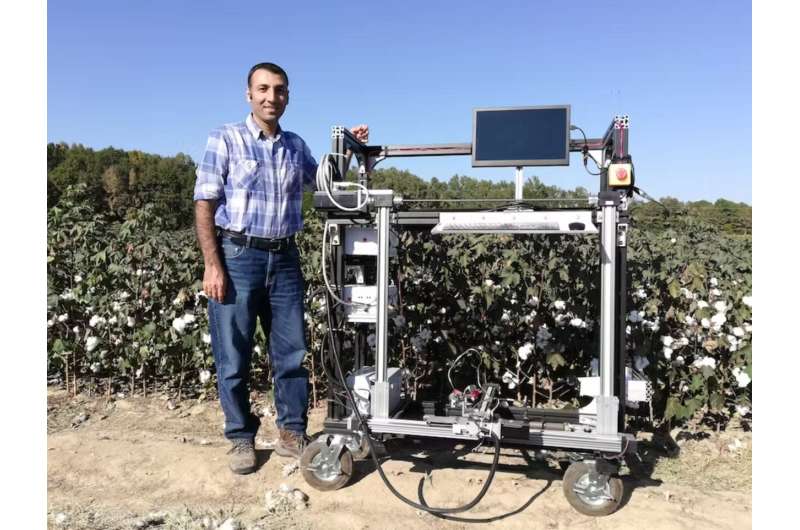
Cotton is one of the most valuable crops grown in the U.S., with a harvest value of some US$7 billion yearly. It is cultivated across a crescent of 17 states stretching from Virginia to California and is used in virtually every type of clothing, as well as in medical supplies and home goods such as upholstery.
Cotton grows inside a hard, fibrous case called a boll. About 100 days after planting, the bolls mature and split open, revealing thousands of fluffy white fibers inside. Each boll contains 20 to 40 seeds with fibers attached to them, which is why the cotton plant's fruit is called seed cotton.
Picking cotton manually, as is still done in some major producing countries, is a meticulous task. Workers have to bend to reach the bolls and can hurt their hands on hard, dry parts of the plants. To harvest the seed cotton, they have to grab and twist it to separate it from the boll without leaving fiber behind.
Starting in the 1930s, cotton farmers in the U.S. shifted from manual labor to large, heavy harvesters. Now the industry is entering a new stage that promises to be more efficient and precise.
I am an engineer and have nearly 20 years of research experience working on agricultural machinery. My current focus is on agricultural robotics and automation. During my Ph.D. program at Mississippi State University, I worked with Alex Thomasson, who heads the agricultural and biological engineering department and the Agricultural Autonomy Institute, to develop a robotic cotton harvester that picks cotton with less damage to the product and the soil where it grows.
Why use robotics?
Cotton farmers have economic, environmental and agricultural reasons to want a better option for harvesting. Traditional mechanical harvesters can be up to 14 feet long and weigh more than 30 tons. They remove cotton effectively without damaging the plants but also can cause problems.
One issue is prolonged fiber exposure. Cotton bolls don't all mature at the same time; the first open bolls in a field may wait for up to 50 days to be picked, until more bolls around them ripen.
Another challenge is that harvesting machines compact the soil as they roll over it. This makes it harder for water and fertilizer to penetrate down to plant roots. And the machines cost roughly US$1 million apiece but are used for only two to three months each year.
Robotics is a potential solution that farmers are already using for other crops, such as fruits and vegetables. Harvesting robots use cameras and sensors to detect when crops are ready to pick and can remove them without damaging the plant.
For cotton, robotics offers more targeted picking of bolls that are ready to harvest. It produces better-quality cotton fiber by picking seed cotton as soon as the bolls open, without leaving it exposed to the weather. The robot targets the seed cotton and avoids touching other parts of the plant.
With robotic picking, cotton farmers don't need to use defoliants to remove leaves from the plants prior to harvesting, which is a common practice now. And small, nimble robots don't compress the soil as they move over it, so they help maintain soil health.
This article is republished from The Conversation under a Creative Commons license. Read the original article.![]()
Citation: Our robot harvests cotton by reaching out and plucking it, like a lizard's tongue snatching flies (2024, February 13) retrieved 13 February 2024 from https://techxplore.com/news/2024-02-robot-harvests-cotton-plucking-lizard.html
This document is subject to copyright. Apart from any fair dealing for the purpose of private study or research, no part may be reproduced without the written permission. The content is provided for information purposes only.
